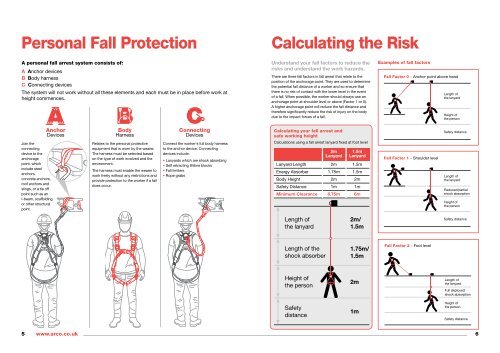Arco Training and Consultancy
1LfRqWt
1LfRqWt
You also want an ePaper? Increase the reach of your titles
YUMPU automatically turns print PDFs into web optimized ePapers that Google loves.
Personal Fall Protection<br />
Calculating the Risk<br />
A personal fall arrest system consists of:<br />
A Anchor devices<br />
B Body harness<br />
C Connecting devices<br />
The system will not work without all these elements <strong>and</strong> each must be in place before work at<br />
height commences.<br />
Join the<br />
connecting<br />
device to the<br />
anchorage<br />
point, which<br />
include steel<br />
anchors,<br />
concrete anchors,<br />
roof anchors <strong>and</strong><br />
slings, or a tie off<br />
point such as an<br />
I-beam, scaffolding<br />
or other structural<br />
point.<br />
Anchor<br />
Devices<br />
BBody<br />
Harness<br />
Relates to the personal protective<br />
equipment that is worn by the wearer.<br />
The harness must be selected based<br />
on the type of work involved <strong>and</strong> the<br />
environment.<br />
The harness must enable the wearer to<br />
work freely without any restrictions <strong>and</strong><br />
provide protection to the worker if a fall<br />
does occur.<br />
C<br />
Connecting<br />
Devices<br />
Connect the worker's full body harness<br />
to the anchor device. Connecting<br />
devices include:<br />
• Lanyards which are shock absorbing<br />
• Self retracting lifeline blocks<br />
• Fall limiters<br />
• Rope grabs<br />
Underst<strong>and</strong> your fall factors to reduce the<br />
risks <strong>and</strong> underst<strong>and</strong> the work hazards.<br />
There are three fall factors in fall arrest that relate to the<br />
position of the anchorage point. They are used to determine<br />
the potential fall distance of a worker <strong>and</strong> so ensure that<br />
there is no risk of contact with the lower level in the event<br />
of a fall. When possible, the worker should always use an<br />
anchorage point at shoulder level or above (Factor 1 or 0).<br />
A higher anchorage point will reduce the fall distance <strong>and</strong><br />
therefore significantly reduce the risk of injury on the body<br />
due to the impact forces of a fall.<br />
Calculating your fall arrest <strong>and</strong><br />
safe working height<br />
Calculations using a fall arrest lanyard fixed at foot level<br />
2m 1.5m<br />
Lanyard Lanyard<br />
Lanyard Length 2m 1.5m<br />
Energy Absorber 1.75m 1.5m<br />
Body Height 2m 2m<br />
Safety Distance 1m 1m<br />
Minimum Clearance 6.75m 6m<br />
Examples of fall factors<br />
Fall Factor 0 - Anchor point above head<br />
Fall Factor 1 - Shoulder level<br />
Length of<br />
the lanyard<br />
Height of<br />
the person<br />
Safety distance<br />
Length of<br />
the lanyard<br />
Reduced/partial<br />
shock absorption<br />
Height of<br />
the person<br />
Length of<br />
the lanyard<br />
2m/<br />
1.5m<br />
Safety distance<br />
Length of the<br />
shock absorber<br />
1.75m/<br />
1.5m<br />
Fall Factor 2 - Foot level<br />
Height of<br />
the person<br />
Safety<br />
distance<br />
2m<br />
1m<br />
Length of<br />
the lanyard<br />
Full deployed<br />
shock absorption<br />
Height of<br />
the person<br />
Safety distance<br />
5 www.arco.co.uk<br />
6


